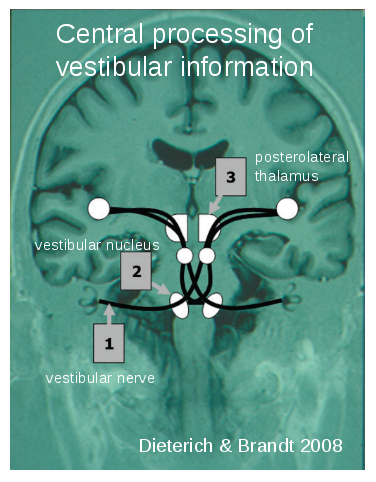Project D2 – Visual-vestibular and visuo-visual cortical interaction
PET and fMRI studies have revealed a reciprocal visual-vestibular interaction for spatial orientation and motion perception that is inhibitory instead of excitatory [1]. Furthermore, using half-field motion stimulation, we found deactivation in contralateral primary visual cortex together with activation of motion-sensitive areas MT/V5. This inter- and intrasensory interaction may allow the brain to reinterpret incongruent visual-vestibular inputs and contradictory motion stimulation of the right and left hemispheres. To explain our results, we have proposed [2] a simple model of transhemispheric visuo-visual interaction. Its  basic mechanism is a central predictor that uses optimal filtering to detect a mismatch between inputs to both hemispheres. This model suggested that the expectation of sensory stimulation modulates brain activation during visual motion stimulation. Through a more detailed analysis based on multimodal sensory integration in neuronal maps, we have shown how supervised spike-timing-dependent plasticity and inhibitory teacher signals can underlie the learning of multimodal integration [3].
basic mechanism is a central predictor that uses optimal filtering to detect a mismatch between inputs to both hemispheres. This model suggested that the expectation of sensory stimulation modulates brain activation during visual motion stimulation. Through a more detailed analysis based on multimodal sensory integration in neuronal maps, we have shown how supervised spike-timing-dependent plasticity and inhibitory teacher signals can underlie the learning of multimodal integration [3].
Objectives and description of work: Visual-vestibular interaction for spatial orientation is thought to rely on dynamic Bayesian inference (see [4] for a review). But how do such models, devised on an abstract functional level, relate to brain activation following multimodal stimuli? Is it possible to unify ideas resulting from multimodal interaction in neural maps [3] with those coming from probabilistic models? In the present project, we aim to answer such questions based on developing more detailed neuronal models and on the analysis of imaging data and psychophysics (Bernstein VR Facility), which will be extended to neurological patients with unilateral ischemic lesions of the vestibular cortex (spatial neglect) and the visual cortex. Our goal is to replicate psychophysical results in a model framework that is close enough to known anatomy, e.g., by taking the known transcallosal and visual-vestibular connectivity into account, to achieve a better understanding and interpretation of imaging data acquired from healthy subjects and patients.
[1]: Dieterich & Brandt Brain 2008. [2]: Brandt et al. Ann NY Acad Sci 2005. [3]: Friedel & van Hemmen Biol Cybern 2008. [4]: MacNeilage et al. J Neurophysiol 2008.

